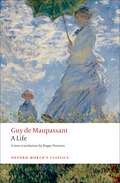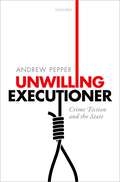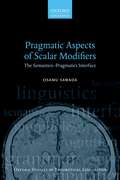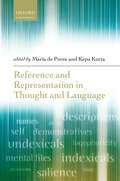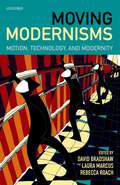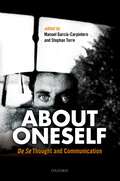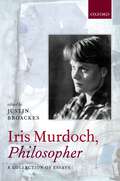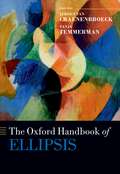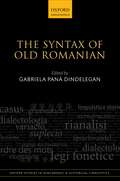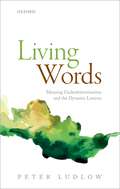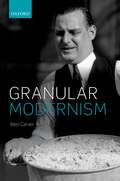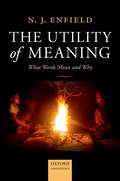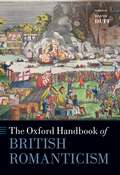- Table View
- List View
The Mind of the Book: Pictorial Title-Pages
by Alastair FowlerAlastair Fowler presents a fascinating study of title-pages printed in England from the early modern period to the nineteenth century. He examines pictorial title-pages in the context of the History of the Book for the first time. The first part of The Mind of the Book explores the forerunner of the frontispiece in late antiquity; the use of frames and borders in title-pages; portraits; printers' devices; emblematic title-pages of the sixteenth and seventeenth centuries, especially attending to explanatory verses and arcane features such as chronograms; title-pages as 'memory prompts'; and eighteenth and nineteenth-century title-pages, tracing 'the rejection of emblematic and symbolic features and the introduction of unadorned, unpictorial, title-pages'. The second part of the book presents illustrations of sixteen significant title-pages with commentaries, ranging from Chaucer's Works in 1532 through Bacon's Instauratio Magna in 1620, Dicken's The Mystery of Edwin Drood in 1870, and arriving back at Chaucer with Edward Burnes-Jones's illustrated title-page for the Works of 1896.
A Life: The Humble Truth (Oxford World's Classics Ser.)
by Guy De Maupassant Roger Pearson`every heart imagines itself the first to thrill to a myriad sensations which once stirred the hearts of the earliest creatures and which will again stir the hearts of the last men and women to walk the earth' What is a life? How shall a storyteller conceive a life? What if art means pattern and life has none? How, then, can any story be true to life? These are some of the questions which inform the first of Maupassant's six novels, A Life (Une Vie) (1883) in which he sought to parody and expose the folly of romantic illusion. An unflinching presentation of a woman's life of failure and disappointments, where fulfilment and happiness might have been expected, A Life recounts Jeanne de Lamare's gradual lapse into a state of disillusion. With its intricate network of parallels and oppositions, A Life reflects the influence of Flaubert in its attention to form and its coherent structure. It also expresses Maupassant's characteristic naturalistic vision in which the satire of bourgeois manners, the representation of the aristocracy in pathological decline, the undermining of human individuality and ideals, and the study of deterioration and disintegration, all play a role. But above all Maupassant brings to his first novel the short story writer's genius for a focused tension between stasis and change, and A Life is one of his most compelling portraits of dispossession and powerlessness. ABOUT THE SERIES: For over 100 years Oxford World's Classics has made available the widest range of literature from around the globe. Each affordable volume reflects Oxford's commitment to scholarship, providing the most accurate text plus a wealth of other valuable features, including expert introductions by leading authorities, helpful notes to clarify the text, up-to-date bibliographies for further study, and much more.
Shakespeare's Sonnets and Poems: A Very Short Introduction (Very Short Introductions)
by Jonathan F. PostNot for nothing is William Shakespeare considered possibly the most famous writer in history; his works have had a lasting effect on culture, vocabularies, and art. His plays contain some of our most well-known lines (how often have you heard the phrase 'To be or not to be'?), yet whilst his poems may often feel less familiar than his plays they have also seeped into our cultural history (who has not heard of ''Shall I compare thee to a summer's day'?). In this Very Short Introduction Jonathan Post introduces all of Shakespeare's poetry: the Sonnets; the two great narrative poems, Venus and Adonis and The Rape of Lucrece; A Lover's Complaint; and The Phoenix and Turtle. Describing Shakespeare's double identity as both poet and playwright, in conjunction with several of his contemporaries, Post evaluates the reciprocal advantages as well as the different strategies and strains that came with writing for the stage and the page. Tackling the debates surrounding the disputed authorship of Shakespeare's poems, he also considers the printing history of Shakespeare's canon, and the genres favoured by the bard. Exploring their reception, both with contemporary audiences and through the ages until today, Post explores the core themes of love and lust, and analyzes how the sonnets compare with other great love poetry of the English Renaissance. ABOUT THE SERIES: The Very Short Introductions series from Oxford University Press contains hundreds of titles in almost every subject area. These pocket-sized books are the perfect way to get ahead in a new subject quickly. Our expert authors combine facts, analysis, perspective, new ideas, and enthusiasm to make interesting and challenging topics highly readable.
Shakespeare's Sonnets and Poems: A Very Short Introduction (Very Short Introductions)
by Jonathan F. PostNot for nothing is William Shakespeare considered possibly the most famous writer in history; his works have had a lasting effect on culture, vocabularies, and art. His plays contain some of our most well-known lines (how often have you heard the phrase 'To be or not to be'?), yet whilst his poems may often feel less familiar than his plays they have also seeped into our cultural history (who has not heard of ''Shall I compare thee to a summer's day'?). In this Very Short Introduction Jonathan Post introduces all of Shakespeare's poetry: the Sonnets; the two great narrative poems, Venus and Adonis and The Rape of Lucrece; A Lover's Complaint; and The Phoenix and Turtle. Describing Shakespeare's double identity as both poet and playwright, in conjunction with several of his contemporaries, Post evaluates the reciprocal advantages as well as the different strategies and strains that came with writing for the stage and the page. Tackling the debates surrounding the disputed authorship of Shakespeare's poems, he also considers the printing history of Shakespeare's canon, and the genres favoured by the bard. Exploring their reception, both with contemporary audiences and through the ages until today, Post explores the core themes of love and lust, and analyzes how the sonnets compare with other great love poetry of the English Renaissance. ABOUT THE SERIES: The Very Short Introductions series from Oxford University Press contains hundreds of titles in almost every subject area. These pocket-sized books are the perfect way to get ahead in a new subject quickly. Our expert authors combine facts, analysis, perspective, new ideas, and enthusiasm to make interesting and challenging topics highly readable.
Culture, Northern Ireland, and the Second World War
by Guy WoodwardCulture, Northern Ireland, and the Second World War explores the impact of the Second World War on literature and culture in Northern Ireland between 1939 and 1970. It argues that the war, as a unique interregnum in the history of Northern Ireland, challenged the entrenched political and social makeup of the province and had a profound effect on its cultural life. Critical approaches to Northern Irish literature and culture have often been circumscribed by topographies of partition and sectarianism, but the Second World War generated conditions for reimagining the province within broader European and global contexts. These have perhaps been obscured by the amount of critical attention that has been paid to the impact of the Troubles on the culture of the province, and for this reason the book focuses on material produced before the flaring of political violence towards the end of the 1960s. Drawing on archival research, over four chapters the book describes the activities of an eccentric collection of artists and writers during and after the Second World War, and considers how the awkward position of the province in relation to the war is reflected in their work
Representing Avarice in Late Renaissance France
by Jonathan PattersonWhy did people talk so much about avarice in late Renaissance France, nearly a century before Molière's famous comedy, L'Avare? As wars and economic crises ravaged France on the threshold of modernity, avarice was said to be flourishing as never before. Yet by the late sixteenth century, a number of French writers would argue that in some contexts, avaricious behaviour was not straightforwardly sinful or harmful. Considerations of social rank, gender, object pursued, time, and circumstance led some to question age-old beliefs. Traditionally reviled groups (rapacious usurers, greedy lawyers, miserly fathers, covetous women) might still exhibit unmistakable signs of avarice — but perhaps not invariably, in an age of shifting social, economic and intellectual values. Across a large, diverse corpus of French texts, Jonathan Patterson shows how a range of flexible genres nourished by humanism tended to offset traditional condemnation of avarice and avares with innovative, mitigating perspectives, arising from subjective experience. In such writings, an avaricious disposition could be re-described as something less vicious, excusable, or even expedient. In this word history of avarice, close readings of well-known authors (Marguerite de Navarre, Ronsard, Montaigne), and of their lesser-known contemporaries are connected to broader socio-economic developments of the late French Renaissance (c.1540-1615). The final chapter situates key themes in relation to Molière's L'Avare. As such, Representing Avarice in Late Renaissance France newly illuminates debates about avarice within broader cultural preoccupations surrounding gender, enrichment and status in early modern France.
Unwilling Executioner: Crime Fiction and the State
by Andrew PepperWhat gives crime fiction its distinctive shape and form? What makes it such a compelling vehicle of social and political critique? Unwilling Executioner argues that the answer lies in the emerging genre's complex and intimate relationship with the bureaucratic state and modern capitalism, and the contradictions that ensue once the state assumes control of the criminal justice system. This study offers a dramatic new interpretation of the genre's emergence and evolution over a three hundred year period and as a genuinely transnational phenomenon. From its roots in the tales of criminality circulated widely in Paris and London in the early eighteenth century, this book examines the extraordinary richness, diversity and complexity of the genre's subsequent thematizations of crime and policing—moving from France and Britain and from continental Europe and the United States to other parts of the globe. In doing so it offers new ways of reading established crime novelists like Gaboriau, Doyle, Hammett, and Simenon, beyond their national contexts and an impulse to characterize their work as either straightforwardly 'radical' or 'conservative'. It also argues for the centrality of writers like Defoe, Gay, Godwin, Vidocq, Morrison, and more recently Manchette, Himes, and Sjöwall and Wahlöö to a project where crime and policing are rooted, and shown to be rooted, in the social and economic conditions of their time. These are all deeply political writers even if their novels exhibit no interest in directly promoting political causes or parties. The result is an agile, layered, and far-reaching account of the crime story's ambivalent relationship to the justice system and its move to complicate our understanding of what crime is and how society is policed and for whose benefit.
Pragmatic Aspects of Scalar Modifiers: The Semantics-Pragmatics Interface (Oxford Studies in Theoretical Linguistics #69)
by Osamu SawadaThis volume examines the meaning of scalar modifiers - expressions such as more than, a bit, and much - from the standpoint of the interface between semantics and pragmatics. In natural language, scalar expressions such as comparatives, intensifiers, and minimizers are used for measuring an object or event at a semantic level. However, cross-linguistically scalar modifiers can often be used to express a range of subjective feelings or discourse pragmatic information at the level of conventional implicature (CI). For example, in English more than anything can signal the degree of importance of the given utterance, and in Japanese the minimizer chotto 'a bit' can weaken the degree of imposition of the speech act. In this book, Osamu Sawada draws on data from Japanese and a range of other languages to explore the dual-use phenomenon of scalar modifiers: he claims that although semantic scalar meanings and CI scalar meanings are logically different, the relationship between the two makes it crucial to examine them both together. The volume provides a new perspective on the semantic-pragmatics interface, and will be of interest to researchers and students of Japanese linguistics, semantics and pragmatics, and theoretical linguistics more generally.
Reference and Representation in Thought and Language
This volume offers novel views on the precise relation between reference to an object by means of a linguistic expression and our mental representation of that object, long a source of debate in the philosophy of language, linguistics, and cognitive science. Chapters in this volume deal with our devices for singular reference and singular representation, with most focusing on linguistic expressions that are used to refer to particular objects, persons, or places. These expressions include proper names such as Mary and John; indexicals such as I and tomorrow; demonstrative pronouns such as this and that; and some definite and indefinite descriptions such as The Queen of England or a medical doctor. Other chapters examine the ways we represent objects in thought, particularly the first-person perspective and the self, and one explores a notion common to reference and representation: salience. The volume includes the latest views on these complex topics from some of the most prominent authors in the field and will be of interest to anyone working on issues of reference and representation in thought and language.
Moving Modernisms: Motion, Technology, and Modernity
The essays in Moving Modernisms: Motion, Technology, and Modernity, written by renowned international scholars, open up the many dimensions and arenas of modernist movement and movements: spatial, geographical and political: affective and physiological; temporal and epochal; technological, locomotive and metropolitan; aesthetic and representational. Individual essays explore modernism's complex geographies, focusing on Anglo-European modernisms while also engaging with the debates engendered by recent models of world literatures and global modernisms. From questions of space and place, the volume moves to a focus on movement and motion, with topics ranging from modernity and bodily energies to issues of scale and quantity. The final chapters in the volume examine modernist film and the moving image, and travel and transport in the modern metropolis. 'Movement is reality itself', the philosopher Henri Bergson wrote: the original and illuminating essays in Moving Modernisms point in new ways to the realities, and the fantasies, of movement in modernist culture.
Authorial Personality and the Making of Renaissance Texts: The Force of Character
by Douglas S. PfeifferHow did we first come to believe in a correspondence between writers' lives and their works? When did the person of the author—both as context and target of textual interpretation—come to matter so much to the way we read? This book traces the development of author centrism back to the scholarship of early Renaissance humanists. Working against allegoresis and other traditions of non-historicizing textual reception, they discovered the power of engaging ancient works through the speculative reconstruction of writers' personalities and artistic motives. To trace the multi-lingual and eventually cross-cultural rise of reading for the author, this book presents four case studies of resolutely experimental texts by and about writers of high ambition in their respective generations: Lorenzo Valla on the forger of the Donation of Constantine, Erasmus on Saint Jerome, the poet George Gascoigne on himself, and Fulke Greville on Sir Philip Sidney. An opening methodological chapter and exhortative conclusion frame these four studies with accounts of the central lexicon—character, intention, ethos, persona—and the range of genre evidence that contemporaries used to discern and articulate authorial character and purpose. Constellated throughout with examples from the works of major contemporaries including John Aubrey, John Hayward, Galileo, Machiavelli, and Shakespeare, this volume resurrects a vibrant culture of biographism continuous with modern popular practice and yet radically more nuanced in its strategic reliance on the explanatory power of probabilism and historical conjecture—the discursive middle ground now obscured from view by the post-Enlightenment binaries of truth and fiction, history and story, fact and fable.
About Oneself: De Se Thought and Communication
This volume addresses foundational issues concerning the nature of first-personal, or de se, thought and how such thoughts are communicated. One of the questions addressed is whether there is anything distinctive about first-person thought or whether it can be subsumed under broader phenomena. Many have held that first-person thought motivates a revision of traditional accounts of content or motivates positing special ways of accessing such contents. Gottlob Frege famously held that first-person thoughts involve a subject being 'presented to himself in a particular and primitive way, in which he is presented to no-one else.' However, as Frege also noted, this raises many puzzling questions when we consider how we are able to communicate such thoughts. Is there indeed something special about first-person thought such that it requires a primitive mode of presentation that cannot be grasped by others? If there really is something special about first-person thought, what happens when I communicate this thought to you? Do you come to believe the very thing that I believe? Or is my first-person belief only entertained by me? If it is only entertained by me, how does it relate to what you come to believe? It is these questions that the volume addresses and seeks to answer.
Iris Murdoch, Philosopher
by Justin BroackesIris Murdoch was a notable philosopher before she was a notable novelist and her work was brave, brilliant, and independent. She made her name first for her challenges to Gilbert Ryle and behaviourism, and later for her book on Sartre (1953), but she had the greatest impact with her work in moral philosophy—and especially her book The Sovereignty of Good (1970). She turned expectantly from British linguistic philosophy to continental existentialism, but was dissatisfied there too; she devised a philosophy and a style of philosophy that were distinctively her own. Murdoch aimed to draw out the implications, for metaphysics and the conception of the world, of rejecting the standard dichotomy of language into the 'descriptive' and the 'emotive'. She aimed, in Wittgensteinian spirit, to describe the phenomena of moral thinking more accurately than the 'linguistic behaviourists' like R. M. Hare. This 'empiricist' task could be acheived, Murdoch thought, only with help from the idealist tradition of Kant, Hegel, and Bradley. And she combined with this a moral psychology, or theory of motivation, that went back to Plato, but was influenced by Freud and Simone Weil. Murdoch's impact can be seen in the moral philosophy of John McDowell and, in different ways, in Richard Rorty and Charles Taylor, as well as in the recent movements under the headings of moral realism, particularism, moral perception, and virtue theory. This volume brings together essays by critics and admirers of Murdoch's work, and includes a longer Introduction on Murdoch's career, reception, and achievement. It also contains a previously unpublished chapter from the book on Heidegger that Murdoch had been working on shortly before her death, and a Memoir by her husband John Bayley. It gives not only an introduction to Murdoch's important philosophical life and work, but also a picture of British philosophy in one of its heydays and at an important moment of transition.
Negation and Nonveridicality in the History of Greek (Oxford Studies in Diachronic and Historical Linguistics #32)
by Katerina ChatzopoulouThis book provides a thorough investigation of the expression of sentential negation in the history of Greek. It draws on both quantitative data from texts dating from three major stages of vernacular Greek (Attic Greek, Koine, and Late Medieval Greek), and qualitative data from all stages of the language, from Homeric Greek to Standard Modern Greek. Katerina Chatzopoulou accounts for the contrast between the two complementary negators found in Greek, referred to as a NEG1 and NEG2, in terms of the latter's sensitivity to nonveridicality, and explains the asymmetry observed in the diachronic development of the Greek negator system. The volume also sets out a new interpretation of Jespersen's cycle, which abstracts away from the morphosyntactic and phonological properties of the phenomenon and proposes instead that it is best understood in semantic terms. This approach not only explains the patterns observed in Greek, but also those found in other languages that deviate from the traditional description of Jespersen's cycle.
The Oxford Handbook of Ellipsis (Oxford Handbooks)
by Jeroen Van Craenenbroeck Tanja TemmermanThis Handbook is the first volume to provide a comprehensive, in-depth, and balanced discussion of ellipsis phenomena, whereby the meaning of an utterance is richer than would be expected based solely on its linguistic form. Natural language abounds in these apparently incomplete expressions, such as I laughed but Ed didn't, in which the final portion of the sentence, the verb 'laugh', remains unpronounced but is still understood. The range of phenomena involved raise general and fundamental questions about the workings of grammar, but also constitute a treasure trove of fine-grained points of inter- and intralinguistic variation. The volume is divided into four parts. In the first, authors examine the role that ellipsis plays and how it is analysed in different theoretical frameworks and linguistic subdisciplines, such as HPSG, construction grammar, inquisitive semantics, and computational linguistics. Chapters in the second part highlight the usefulness of ellipsis as a diagnostic tool for other linguistic phenomena including movement and islands and codeswitching, while part III focuses instead on the types of elliptical constructions found in natural language, such as sluicing, gapping, and null complement anaphora. Finally, the last part of the book contains case studies that investigate elliptical phenomena in a wide variety of languages, including Dutch, Japanese, Persian, and Finnish Sign Language.
The Oxford Handbook of Ellipsis (Oxford Handbooks)
This Handbook is the first volume to provide a comprehensive, in-depth, and balanced discussion of ellipsis phenomena, whereby the meaning of an utterance is richer than would be expected based solely on its linguistic form. Natural language abounds in these apparently incomplete expressions, such as I laughed but Ed didn't, in which the final portion of the sentence, the verb 'laugh', remains unpronounced but is still understood. The range of phenomena involved raise general and fundamental questions about the workings of grammar, but also constitute a treasure trove of fine-grained points of inter- and intralinguistic variation. The volume is divided into four parts. In the first, authors examine the role that ellipsis plays and how it is analysed in different theoretical frameworks and linguistic subdisciplines, such as HPSG, construction grammar, inquisitive semantics, and computational linguistics. Chapters in the second part highlight the usefulness of ellipsis as a diagnostic tool for other linguistic phenomena including movement and islands and codeswitching, while part III focuses instead on the types of elliptical constructions found in natural language, such as sluicing, gapping, and null complement anaphora. Finally, the last part of the book contains case studies that investigate elliptical phenomena in a wide variety of languages, including Dutch, Japanese, Persian, and Finnish Sign Language.
Making New Words: Morphological Derivation in English
by R. M. DixonMaking New Words provides a detailed study of the 200 or so prefixes and suffixes which create new words in today's English. Alongside a systematic discussion of these forms, Professor Dixon explores and explains the hundreds of conundrums that seem to be exceptions to general rules. Why, for instance, do we say un-distinguished (with prefix un-) but in-distinguishable (with in-); why un-ceasing but in-cesssant? Why, alongside gold-en, do we say silver-y (not silver-en)? Why is it wood-en (not wood-ic) but metall-ic (not metall-en)? After short preliminary chapters, which set the scene and outline the criteria employed, there are accounts of the derivation of negative words, of other derivations which do not change word class, on making new verbs, new adjectives, new nouns, and new adverbs. The final chapter deals with combinations of suffixes, of prefixes, and of the two together. Within each chapter, derivational affixes are arranged in semantic groups, the members of which are contrasted with respect to meaning and function; for example, child-less and child-free. For each affix there is an account of its genetic origin (from Old English, Greek, Latin, French, and so on), its phonological form and implications for stress placement, the roots it can be attached to (and why), and how its range of meanings has developed over the centuries. The book is written in the author's accustomed style - clear and well-organised, with easy-to-understand explanations. The exposition is illustrated by examples, ranging from Shakespeare, W. S. Gilbert, and modern novels to what was heard on the radio. It will be an invaluable text and sourcebook for scholars and students of the English language and of general linguistics, from undergraduate level upwards. The many fascinating facts presented here, in such a lucid and accessible manner, will also appeal to the general reader interested in picking to pieces the English language to see how it works.
The Syntax of Old Romanian (Oxford Studies in Diachronic and Historical Linguistics #19)
This book provides the first comprehensive overview of the syntax of old Romanian written in English and targeted at a non-Romanian readership. It draws on an extensive new corpus analysis of the period between the beginning of the sixteenth century, the date of the earliest attested Romanian texts, and the end of the eighteenth century, generally considered to mark the start of the modernization of Romanian. Gabriela Pană Dindelegan and her co-authors adopt both a synchronic and diachronic approach by providing a detailed corpus analysis in a given period, while also comparing old and modern Romanian. They examine the evolution of a variety of syntactic phenomena, including the elimination or diminishing of certain facts or generalization of others, the total or partial grammaticalization of phenomena, competition between structures, and cases of syntactic variation. The book takes a typological and comparative perspective, focusing on those phenomena that are considered specific to Romanian (either on the Romance or in the Balkan area), and adopts a modern framework while still remaining accessible to readers from any background.
Defaults in Morphological Theory
Chapters in this volume describe morphology using four different frameworks that have an architectural property in common: they all use defaults as a way of discovering and presenting systematicity in the least systematic component of grammar. These frameworks - Construction Morphology, Network Morphology, Paradigm-function Morphology, and Word Grammar - display key differences in how they constrain the use and scope of defaults, and in the morphological phenomena that they address. An introductory chapter presents an overview of defaults in linguistics and specifically in morphology. In subsequent chapters, key proponents of the four frameworks seek to answer questions about the role of defaults in the lexicon, including: Does a defaults-based account of language have implications for the architecture of the grammar, particularly the proposal that morphology is an autonomous component? How does a default differ from the canonical or prototypical in morphology? Do defaults have a psychological basis? And how do defaults help us understand language as a sign-based system that is flawed, where the one to one association of form and meaning breaks down in the morphology?
Living Words: Meaning Underdetermination and the Dynamic Lexicon
by Peter LudlowPeter Ludlow shows how word meanings are much more dynamic than we might have supposed, and explores how meanings are modulated (changed) even during the course of our everyday conversations. When we engage with communicative partners we build micro-languages on the fly—languages that may be fleeting, but which serve our joint interests. Sometimes we sync up on word meanings without reflection, but in many cases we debate the proper modulation of the meanings of our words. Living Words explores the norms that govern the ways in which we litigate word meanings. The resulting view is radical, and Ludlow shows that it has far-reaching consequences for our political and legal discourse and also for some of the deepest and most intractable puzzles that have gripped English-language philosophy for the past 100 years—including puzzles in the foundations of semantics, epistemology, and logic.
Granular Modernism
by Beci CarverGranular Modernism understands the way that some Modernist texts put themselves together as a way of pulling themselves apart. In this volume, Beci Carver offers a new way of reading Modernist novels and poems , by drawing attention to the anomalies that make them difficult to summarise or simplify. Carver proposes that rather than trying to find the shapes of narrative or argument in their writing, the 'Granular Modernists' - namely, Joseph Conrad, William Gerhardie, Evelyn Waugh, Henry Green, T.S. Eliot, W.H. Auden, and Samuel Beckett - experiment in certain of their works in finding the shapelessness of a moment in history that increasingly confidently called itself 'modern', which was to call itself shapeless. The project of Modernism in the late nineteenth and the first half of the twentieth century, was to find a story to tell about an era full of beginnings. The project of 'Granular Modernism' was to find a way of turning the inchoateness of the modern moment into art. Granular Modernism takes from the Naturalist movements of the nineteenth and early twentieth century its attentiveness to the process of mundane experiences like eating or waiting. But where Naturalism sets out to offer a complete picture of a way of life, Granular Modernism's eating and waiting fail to amount to anything more; to paraphrase Evelyn Waugh: 'The most they can hope for is a cumulative futility.' Frank Norris once described one of Stephen Crane's narrators as: 'a locust in a grain elevator attempting to empty the silo by carrying off one grain at a time.' Norris is being dismissive. But his image of pointless, meticulous, indefinite manoeuvre potentially defines the ambition of the Granular Modernists.
Competing Motivations in Grammar and Usage
This volume examines the conflicting factors that shape the content and form of grammatical rules in language usage. Speakers and addressees need to contend with these rules when expressing themselves and when trying to comprehend messages. For example, there are on-going competitions between the speaker's interests and the addressee's needs, or between constraints imposed by grammar and those imposed by online processing. These competitions influence a wide variety of systems, including case marking, agreement and word order, politeness forms, lexical choices, and the position of relative clauses. Chapters in the book analyse grammar and usage in adult language as well as first and second language acquisition, and the motivations that drive historical change. Several of the chapters seek explanations for the competitions involved, based on earlier accounts including the Competition Model, Natural Morphology, the functional-typological tradition, and Optimality Theory. The book will be of interest to linguists from a wide variety of backgrounds, particularly those interested in psycholinguistics, historical linguistics, philosophy of language, and language acquisition, from advanced undergraduate level upwards.
The Utility of Meaning: What Words Mean and Why
by N. J. EnfieldThis book argues that the complex, anthropocentric, and often culture-specific meanings of words have been shaped directly by their history of 'utility' for communication in social life. N. J. Enfield draws on semantic and pragmatic case studies from his extensive fieldwork in Laos to investigate a range of semantic fields including emotion terms, culinary terms, landscape terminology, and honorific pronouns, among many others. These studies form the building blocks of a conceptual framework for understanding meaning in language. The book argues that the goals and relevancies of human communication are what bridge the gap between the private representation of language in the mind and its public processes of usage, acquisition, and conventionalization in society. Professor Enfield argues that in order to understand this process, we first need to understand the ways in which linguistic meaning is layered, multiple, anthropocentric, cultural, distributed, and above all, useful. This wide-ranging account brings together several key strands of research across disciplines including semantics, pragmatics, cognitive linguistics, and sociology of language, and provides a rich account of what linguistic meaning is like and why.
The Oxford Handbook of British Romanticism (Oxford Handbooks)
by David DuffThe Oxford Handbook of British Romanticism offers a comprehensive guide to the literature and thought of the Romantic period, and an overview of the latest research on this topic. Written by a team of international experts, the Handbook analyses all aspects of the Romantic movement, pinpointing its different historical phases and analysing the intellectual and political currents which shaped them. It gives particular attention to devolutionary trends, exploring the English, Scottish, Welsh, and Irish strands in 'British' Romanticism and assessing the impact of the constitutional changes that brought into being the 'United Kingdom' at a time of revolutionary turbulence and international conflict. It also gives extensive coverage to the publishing and reception history of Romantic writing, highlighting the role of readers, reviewers, publishers, and institutions in shaping Romantic literary culture and transmitting its ideas and values. Divided into ten sections, each containing four or five chapters, the Handbook covers key themes and concepts in Romantic studies as well as less chartered topics such as freedom of speech, literature and drugs, Romantic oratory, and literary uses of dialect. All the major male and female Romantic authors are included along with numerous lesser-known writers, the emphasis throughout being on the diversity of Romantic writing and the complexities and internal divisions of the culture that sustained it. The volume strikes a balance between familiarity and novelty to provide an accessible guide to current thinking and a conceptual reorganization of this fast-moving field.
The Oxford Handbook of British Romanticism (Oxford Handbooks)
The Oxford Handbook of British Romanticism offers a comprehensive guide to the literature and thought of the Romantic period, and an overview of the latest research on this topic. Written by a team of international experts, the Handbook analyses all aspects of the Romantic movement, pinpointing its different historical phases and analysing the intellectual and political currents which shaped them. It gives particular attention to devolutionary trends, exploring the English, Scottish, Welsh, and Irish strands in 'British' Romanticism and assessing the impact of the constitutional changes that brought into being the 'United Kingdom' at a time of revolutionary turbulence and international conflict. It also gives extensive coverage to the publishing and reception history of Romantic writing, highlighting the role of readers, reviewers, publishers, and institutions in shaping Romantic literary culture and transmitting its ideas and values. Divided into ten sections, each containing four or five chapters, the Handbook covers key themes and concepts in Romantic studies as well as less chartered topics such as freedom of speech, literature and drugs, Romantic oratory, and literary uses of dialect. All the major male and female Romantic authors are included along with numerous lesser-known writers, the emphasis throughout being on the diversity of Romantic writing and the complexities and internal divisions of the culture that sustained it. The volume strikes a balance between familiarity and novelty to provide an accessible guide to current thinking and a conceptual reorganization of this fast-moving field.

